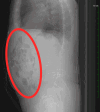Lymphocytic Colitis With Ileal Extension Following Oyster Consumption: A Case Report
- PMID: 41141046
- PMCID: PMC12553397
- DOI: 10.7759/cureus.93190
Lymphocytic Colitis With Ileal Extension Following Oyster Consumption: A Case Report
Abstract
Lymphocytic colitis is an uncommon cause of chronic, non-bloody diarrhea characterized histologically by increased intraepithelial lymphocytes within the colonic mucosa, typically with preserved architecture. We present a case of an 84-year-old Caucasian male patient with a history of hypertension, obstructive sleep apnea, benign prostatic hyperplasia, and essential tremor, who developed persistent watery diarrhea, profound fatigue, and unintentional weight loss of 22 pounds within several days after consuming fried oysters at a local restaurant. Initial evaluation at multiple facilities revealed hypotension, hypokalemia, and acute kidney injury, with negative infectious stool studies, unremarkable abdominal imaging, and no evidence of celiac disease. Despite supportive care and antimotility therapy, symptoms persisted, and the patient required repeat hospitalization. A computed tomography (CT) scan demonstrated colonic air-fluid levels consistent with a diarrheal state without inflammatory changes. Colonic biopsies revealed classic lymphocytic colitis, with rare extension into the terminal ileum. The patient experienced significant improvement after initiation of intravenous methylprednisolone, with resolution of vomiting, reduction in stool frequency, normalization of electrolytes, and improvement in renal function, sustained over several weeks of follow-up. This case highlights the diagnostic challenges of lymphocytic colitis, which may present with subacute symptoms that mimic irritable bowel syndrome or chronic infection. The temporal association with recent oyster consumption raises the possibility of a food antigen-mediated trigger, an uncommon but clinically relevant consideration in the pathogenesis of lymphocytic colitis.
Keywords: colonic biopsy; food antigen; intraepithelial lymphocytosis; lymphocytic colitis; microscopic colitis; non-bloody diarrhea; oyster consumption; refractory diarrhea; seafood-related illness; watery diarrhea.
Copyright © 2025, Najeeb et al.
Conflict of interest statement
Human subjects: Informed consent for treatment and open access publication was obtained or waived by all participants in this study. Conflicts of interest: In compliance with the ICMJE uniform disclosure form, all authors declare the following: Payment/services info: All authors have declared that no financial support was received from any organization for the submitted work. Financial relationships: All authors have declared that they have no financial relationships at present or within the previous three years with any organizations that might have an interest in the submitted work. Other relationships: All authors have declared that there are no other relationships or activities that could appear to have influenced the submitted work.
Figures


References
-
- Differential disease behavior of immune-mediated colitis among different types of immune checkpoint inhibition. Shatila M, Eshaghi F, Cruz CC, et al. Target Oncol. 2025;20:339–347. - PubMed
Publication types
LinkOut - more resources
Full Text Sources
